
Here are 10 beautiful places in Azerbaijan that are must-visit destinations for tourists.
Azerbaijan, often called the “Land of Fire,” boasts a fascinating blend of ancient and modern influences, reflected in its rich historical sites.
1. Maiden Tower (Qız Qalası), Baku:
2. Gobustan National Park:
3. Palace of the Shirvanshahs, Baku:
4. Ateshgah Fire Temple, Surakhani:
5. Sheki Khan’s Palace, Sheki Azerbaijan:
6. Quba Mass Grave Azerbaijan:
7. Albanian Church, Kish Azerbaijan:
8. Lahij Village Azerbaijan:
9. Nakhchivan Mausoleum Azerbaijan
10. Shamakhi Juma Mosque Azerbaijan:
1. Maiden Tower (Qız Qalası), Baku Azerbaijan:
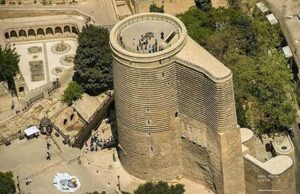
The Maiden Tower (Qız Qalası) is one of the 10 most beautiful places for tourists in Azerbaijan, located in the heart of Baku’s Old Town (Icherisheher), and a must-see for any visitor visiting the capital.
This enigmatic structure, rising to a height of 29.5 meters, dates back to the 12th century, although parts of its foundation may be even older, possibly from the 7th or 8th centuries.
Its unique design and mysterious origins have given rise to numerous legends and interpretations, making it a captivating site for history enthusiasts and curious visitors alike.
Folklore shrouds the Maiden Tower, with one of the most popular legends describing a maiden who threw herself from the tower to escape an unwanted marriage, hence its name.
Another tale suggests it was built by a powerful shah for his beloved daughter. These stories add a layer of romantic intrigue to the historical significance of the tower.
Architecturally, the Maiden Tower is a blend of defensive and residential features, indicative of its historical evolution..
The cylindrical structure is made of limestone; furthermore, its walls are several meters thick, specifically designed to withstand invasions.
Inside, visitors can explore various levels connected by a winding staircase, each offering a glimpse into different eras of Baku’s history.
Exhibits within the tower not only showcase archaeological findings and historical artifacts but also feature multimedia displays that effectively narrate the tower’s rich past.
The panoramic view from the rooftop is a highlight, offering breathtaking vistas of the Caspian Sea and the modern skyline of Baku juxtaposed with the ancient cityscape.
The surrounding area, rich with cobblestone streets, quaint shops, and cafes, adds to the charm of the visit.
2. Gobustan National Park Azerbaijan:
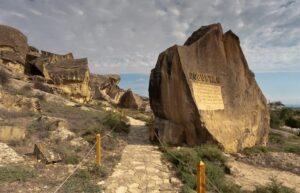
Gobustan National Park is one of the 10 most beautiful places for tourists in Azerbaijan.
It is a UNESCO World Heritage site located about 64 kilometers southwest of Baku and is a fascinating destination for tourists interested in history, archaeology, and natural beauty.
This unique park is renowned for its extensive collection of rock engravings; moreover, these engravings offer a fascinating window into the lives of prehistoric humans.
With over 6,000 petroglyphs dating back 40,000 years, Gobustan is one of the world’s richest sites of ancient rock art.
These petroglyphs depict scenes of hunting, dancing, rituals, and daily activities; consequently, they provide invaluable insights into the social and cultural practices of early human societies.
Various rock shelters, caves, and boulders spread the rock carvings across Gobustan, making a visit an immersive journey through time.
In addition to the petroglyphs, the park is home to ancient mud volcanoes and gas stones, adding to the unique geological landscape of the area.
The Gobustan Museum, located near the entrance of the park, is an excellent starting point for visitors.
The museum features interactive displays, artifacts, and detailed explanations; in addition, it provides information about the history and significance of the rock art as well as the geological features of the region.
It provides context and enhances the overall experience of exploring the park.
One of the highlights of visiting Gobustan is the chance to see the mud volcanoes, which are among the most active in the world.
These natural phenomena are not only intriguing but also offer a stark contrast to the arid landscape of the region.
Gobustan National Park offers a unique blend of natural wonders and historical treasures, making it a must-visit destination for anyone traveling to Azerbaijan.
3. Palace of the Shirvanshahs, Baku Azerbaijan:
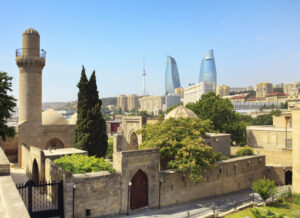
The Palace of the Shirvanshahs is one of the 10 most beautiful places for tourists in Azerbaijan, located in the heart of Baku’s Old City (Icherisheher), is a magnificent architectural gem and a testament to Azerbaijan’s rich medieval history.
Constructed in the 15th century during the reign of the Shirvanshah dynasty, this palace complex is considered one of the finest examples of the Shirvan-Apsheron architectural style.
Stepping into the palace grounds transports you to the height of the Shirvanshah dynasty’s influence.
The complex features a palace, mosque, mausoleum, Diwan Khan, burial vaults, and remnants of a bathhouse.
The complex includes not only the main palace building and a mosque, but also a mausoleum, the Diwan Khan (reception hall), the burial vaults, and, finally, the remnants of a bathhouse.
Each structure within the complex showcases not only intricate stone carvings and elaborate decorations, but also a sophisticated design that, in turn, reflects the advanced architectural techniques of the time.
One of the highlights of the palace is the Divan Khane, an octagonal pavilion used for ceremonial purposes.
Its ornate arches and delicate stone latticework are particularly striking. The Shirvanshah’s Mosque, with its beautifully carved mihrab (prayer niche), adds a spiritual dimension to the complex.
The mausoleum, also known as the tomb of the Shirvanshahs, houses the resting places of several members of the royal family.
The stone tombstones and the tranquil atmosphere provide a poignant reminder of the dynasty’s historical significance.
Visitors can also explore the palace museum, which offers a collection of artifacts, including ceramics, coins, and manuscripts, that provide further insight into the cultural and historical context of the period.
Informative displays and exhibits help narrate the story of the Shirvanshahs and their contributions to Azerbaijani heritage.
4. Ateshgah Fire Temple, Surakhani, Azerbaijan:
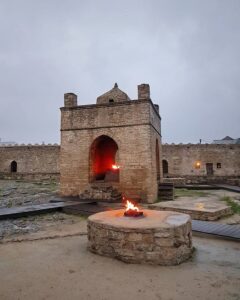
The Ateshgah Fire Temple, located in the Surakhani suburb of Baku, is a unique and fascinating historical site that attracts tourists with its intriguing blend of spirituality, history, and natural phenomena.
Known as the “Fire Temple of Baku,” Ateshgah is not only a testament to Azerbaijan’s ancient connection with fire worship, but it also highlights a significant aspect of both Zoroastrianism and Hinduism.
Constructed in the 17th century, the temple is built on a natural gas vent, where flames have burned for centuries.
The complex features a central altar surrounded by a pentagonal courtyard, which is encircled by a series of small cells. These cells once housed pilgrims and ascetics who traveled from distant lands, drawn by the temple’s eternal flames.
As visitors enter the temple, the sight of the central altar’s ever-burning flame greets them, symbolizing the divine for many of its historical worshippers.
The courtyard cells now serve as small museums; furthermore, each one details different aspects of the temple’s history, the religious practices of its devotees, and the significance of fire worship.
One of the most compelling aspects of Ateshgah is its multicultural history.
Inscriptions in Persian, Sanskrit, and Punjabi attest to the diverse origins of the pilgrims who once visited this sacred site.
The temple’s architecture reflects this blend of influences; moreover, it combines elements typical of both Persian and Indian design.
The informative exhibits not only provide insight into the rituals and beliefs of the temple’s Zoroastrian, Hindu, and Sikh visitors, but they also offer a comprehensive understanding of its spiritual significance.
Additionally, the Ateshgah Fire Temple’s serene and contemplative atmosphere provides a stark contrast to the bustling energy of modern Baku.
5. Sheki Khan’s Palace, Sheki Azerbaijan:
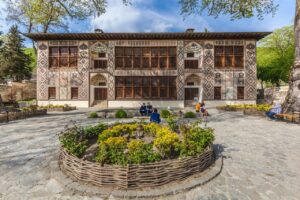
Visiting Sheki Khan’s Palace in Sheki is one of the 10 most beautiful places for tourists in Azerbaijan and is a journey into the heart of Caucasian history and architecture.
Nestled in the lush foothills of the Greater Caucasus Mountains, the palace is an exquisite example of 18th-century Islamic architecture, renowned for its stunning stained glass windows, intricate frescoes, and vibrant tile work.
As you approach the palace, not only does the lush greenery greet you, but also the serene atmosphere sets the tone for a truly enchanting experience.
The builders created the palace as a two-story structure; moreover, they did so without the use of nails, thereby showcasing their exceptional craftsmanship.
Colorful shebeke (stained glass) windows adorn the façade, casting a mesmerizing play of light and color into the interior rooms.
Inside, the palace is a feast for the eyes; furthermore, each room is decorated with intricate patterns and frescoes that depict scenes of hunting, floral motifs, and geometric designs.
The second floor houses the most impressive spaces, including the grand reception hall, where the khans once entertained guests.
Elaborate paintings and stained glass adorn the walls and ceilings here, creating a kaleidoscope of colors and patterns.
A visit to Sheki Khan’s Palace is not just about the visual splendor. It is also an opportunity to delve into the rich history of the Sheki Khanate and its significance in the region.
The palace stands as a symbol of the area’s cultural heritage and its blend of Persian, Ottoman, and local influences.
Tourists can also explore the surrounding Sheki city, which is equally charming with its cobblestone streets, traditional houses, and vibrant bazaars.
6. Sumgayit Azerbaijan:

7. Albanian Church, Kish Azerbaijan:
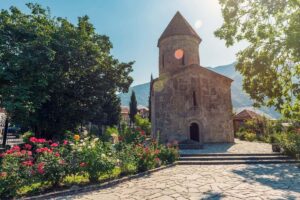
Visiting the Albanian Church in Kish, Azerbaijan, is a captivating experience that transports tourists back to the early Christian period in the Caucasus.
Nestled in the picturesque village of Kish, near Sheki, this ancient church is believed to date back to the 1st century AD, making it one of the 10 most beautiful places for tourists in Azerbaijan and one of the oldest Christian sites in the region.
The journey to Kish is, in fact, a delightful experience; additionally, it offers scenic landscapes of rolling hills and quaint rural villages.
Upon arrival, the church’s modest exterior belies its historical and cultural significance.
The structure, built from local limestone, not only features traditional Caucasian Albanian architectural elements but also offers a glimpse into the region’s rich past.
Inside, the church is a serene sanctuary, with its simple yet elegant design.
Artists adorned the walls with frescoes and inscriptions in ancient Albanian script; consequently, this provides a fascinating insight into the early Christian heritage of the area.
The small museum adjacent to the church houses artifacts and exhibits that detail the history of the Caucasian Albanian people and the spread of Christianity in the region.
One of the most intriguing aspects of the Albanian Church is its role as a cultural and religious symbol.
Over the centuries, it has served various communities, including the Georgian Orthodox and Armenian Apostolic; consequently, this reflects the region’s diverse and intertwined history.
Visitors often remark on the peaceful ambiance of the church and the village of Kish. The site is well-maintained, with informative guides available to share the church’s history and significance.
Combining a visit to the Albanian Church with a trip to nearby Sheki enhances the experience, as tourists can explore Sheki Khan’s Palace and other historical sites.
8. Lahij Village Azerbaijan:
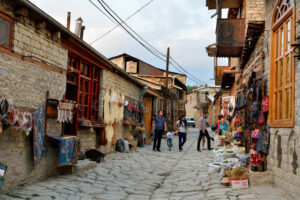
Visiting Lahij Village in Azerbaijan offers tourists a unique glimpse into the country’s rich cultural heritage and traditional crafts.
Nestled in the Ismailli region, high in the mountains of the Greater Caucasus, Lahij is renowned for its preserved cobblestone streets, ancient architecture, and vibrant artisanal community.
The journey to Lahij is an adventure in itself, with winding roads that provide breathtaking views of the surrounding landscape.
Upon arrival, visitors are greeted by the village’s charming atmosphere. The narrow streets, stone houses with wooden balconies, and intricate lattice windows create a picturesque setting that feels like stepping back in time.
Lahij is famous for its skilled craftsmen, particularly coppersmiths, who have been practicing their trade for centuries.
Tourists can wander through the village’s workshops; moreover, they can watch artisans at work, and perhaps even purchase unique, handcrafted items as souvenirs.
The clang of a hammer on metal and the sight of molten copper being shaped into beautiful utensils and ornaments are mesmerizing experiences.
The village also boasts a rich history, with ancient mosques, bathhouses, and a sophisticated sewage system that dates back over a millennium.
The local museum not only offers insights into Lahij’s past, but it also showcases artifacts and exhibits that, in turn, tell the story of the village and its people.
Visitors can enjoy traditional Azerbaijani hospitality in one of the local teahouses or guesthouses, savoring regional dishes and engaging with the friendly residents.
The surrounding nature also provides ample opportunities for hiking and exploring, with scenic trails leading to stunning viewpoints and secluded spots.
Lahij Village is a must-visit destination for those interested in history, culture, and traditional craftsmanship. It offers a serene escape from the modern world, immersing visitors in the timeless beauty and heritage of Azerbaijan.
9. Nakhchivan Mausoleum Azerbaijan:
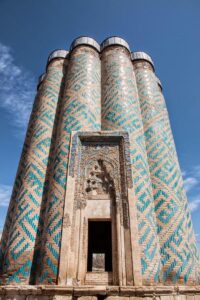
Visiting the Nakhchivan Mausoleum in Azerbaijan is a journey into the heart of ancient history and architectural splendor.
Located in the city of Nakhchivan, this mausoleum, also known as the Momine Khatun Mausoleum, stands as a testament to the rich cultural heritage of the region.
Constructed in the 12th century by architect Ajami Nakhchivani, the mausoleum is an outstanding example of medieval Islamic architecture.
As you approach the site, the ten-sided structure, adorned with intricate geometric patterns and Kufic inscriptions, immediately captures your attention.
The mausoleum’s brickwork, combined with turquoise tiles, creates a striking visual appeal that is both elegant and timeless.
Inside, the mausoleum impresses with intricate designs, featuring elaborate carvings and tile work that highlight the period’s artistic achievements.
The mausoleum was built to honor Momine Khatun, the wife of the Atabeg ruler Shams ad-Din Eldiguz, and it serves as a symbol of enduring love and respect.
A visit to the Nakhchivan Mausoleum provides tourists with more than just a view of an architectural marvel.
It offers a deep dive into the historical and cultural context of the medieval Islamic world; additionally, it provides a comprehensive understanding of the era’s significance.
Informative plaques and guided tours provide insights into the construction techniques, artistic influences, and historical significance of the site.
The city of Nakhchivan itself is rich in history and culture, offering additional attractions such as the ancient Nakhchivan Fortress, the Ashabi-Kahf cave, and the Alinja Castle.
Exploring these sites, along with the Nakhchivan Mausoleum, not only gives visitors a comprehensive understanding of the region’s historical narrative, but it also enhances their appreciation of its cultural significance.
The Nakhchivan Mausoleum is a must-visit for history enthusiasts and architecture buffs, offering an enriching experience in Azerbaijan’s landscape.
10. Shamakhi Juma Mosque Azerbaijan:
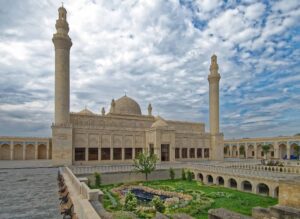
Visiting the Shamakhi Juma Mosque in Azerbaijan offers tourists an enriching experience of Islamic history and architecture. Located in the city of Shamakhi, this mosque is one of the oldest and largest in the Caucasus region, dating back to the 8th century.
The journey to Shamakhi is picturesque; in addition, it features rolling hills and lush landscapes that lead to this historic city.
As you approach the mosque, the grandeur of its architecture immediately stands out.
The Shamakhi Juma Mosque is one of the 10 most beautiful places for tourists in Azerbaijan and has undergone several renovations, the most recent mosque adding modern touches while retaining its original grandeur.
The mosque’s facade features intricate stone carvings and elegant arches, reflecting the craftsmanship of its builders.
Entering the mosque, visitors are greeted by a spacious and serene prayer hall. The interior is adorned with beautiful calligraphy, ornate chandeliers, and meticulously crafted tilework.
The mosque’s dome, a masterpiece of Islamic architecture, is adorned with intricate patterns and Arabic inscriptions, creating a sense of awe and reverence.
The Shamakhi Juma Mosque has a rich history; moreover, it has survived multiple earthquakes and invasions over the centuries.
Each restoration has added layers to its story, making it a living monument to resilience and faith.
Informative plaques and guided tours provide insights into the mosque’s historical significance, architectural features, and the role it has played in the community.
Visitors often feel a profound sense of tranquility and spirituality within the mosque. The surrounding courtyard, with its lush gardens and fountains, offers a peaceful place for reflection and relaxation.
Nearby, tourists can explore other attractions in Shamakhi, such as the Diri Baba Mausoleum and the ancient Yeddi Gumbaz mausoleums.





